Related Research Articles

Capri is an island located in the Tyrrhenian Sea off the Sorrento Peninsula, on the south side of the Gulf of Naples in the Campania region of Italy. The largest settlement on the island is the town of Capri. The island has been a resort since the time of the Roman Republic.
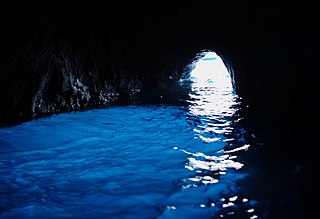
The Blue Grotto is a sea cave on the coast of the island of Capri, southern Italy. Sunlight shining through an underwater cavity is reflected back upward through the seawater below the cavern, giving the water a blue glow that illuminates the cavern. The cave extends some 50 metres into the cliff at the surface, and is about 150 metres (490 ft) deep, with a sandy bottom.

Ponza is the largest island of the Italian Pontine Islands archipelago, located 33 km (21 mi) south of Cape Circeo in the Tyrrhenian Sea. It is also the name of the commune of the island, a part of the province of Latina in the Lazio region.

The Crypta Neapolitana is an ancient Roman road tunnel near Naples, Italy. It was built in 37 BC and is over 700 metres long.
The island of Capri is situated in the Gulf of Naples, between the Italian Peninsula and the islands of Procida and Ischia. Made of limestone, its lowest part is at the center, while its sides are high and mostly surrounded by steep precipices, which contain numerous caves. Its topography is dominated by the slopes of the Monte Solaro in the west and Monte San Michele in the east.
The Campanian Archipelago, also called Neapolitan Archipelago, is an archipelago in the Tyrrhenian Sea, in southwestern Italy. It principally comprises 5 islands: Capri, Ischia, Nisida, Procida, and Vivara. Most of the archipelago belongs to the Metropolitan City of Naples.

Blue Cave is the most celebrated attraction of the Greek island of Kastellorizo, and is a sufficient reason to visit the island. The cave lies on the southeast coast of the island, and is named by the inhabitants Phókiali.
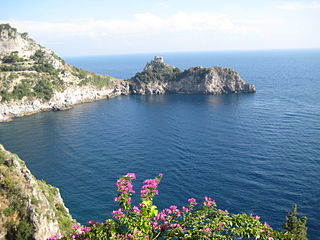
The Grotta dello Smeraldo is a cave, partly inundated by the sea and located in Conca dei Marini, Italy, on the Amalfi Coast.

Via Krupp is a historic hairpin turn paved footpath on the island of Capri, connecting the Charterhouse of San Giacomo and the Gardens of Augustus area with Marina Piccola. Commissioned by the German industrialist Friedrich Alfred Krupp, the path covers an elevation difference of about 100 m (330 ft).
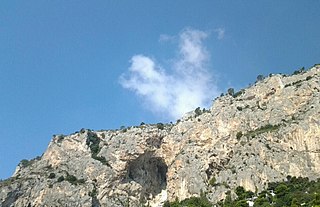
The Grotta delle Felci is a cave located on the island of Capri, in Campania, Italy.

Marina Piccola is located on the southern side of the island of Capri. It is near the Faraglioni sea stacks to the southeast. The Via Krupp is a historic switchback paved footpath which connect the Charterhouse of San Giacomo and the Gardens of Augustus area with Marina Piccola. The Marina Piccola, used by Augustus and Tiberius, preceded the Marina Grande.
Palazzo a Mare is a well-preserved ancient Roman archaeological site on the north side of the island of Capri, consisting of an imperial palace built by Augustus and modified by Tiberius. It was one of the supposed twelve villas of Tiberius on the island as described by Tacitus, along with the Villa Jovis, Villa di Gradola and Villa Damecuta. It covers a very large area on several terraces overlooking the sea.
The Gardens of Augustus, originally known by the name of Krupp Gardens, are botanical gardens on the island of Capri, Campania, Italy.
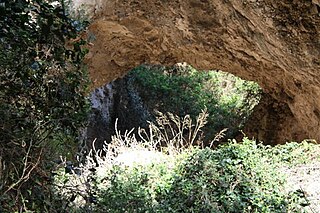
The Grotta di Matromania is a large, natural cave on the east coast of the island of Capri, Italy. It is located near the Arco Naturale. The cave is approximately 27 m long, 18 m wide, and 18 m high. It is connected with Mithras.
The Grotta del Castiglione is a lofty cave on the island of Capri, Italy. It is located high up in the hill of the same name, facing south. When the inhabitants of Capri took refuge in it at the time of the Turkish raids, there was a way to it from the east, but the path has since been destroyed by the crumbling of the cliff.
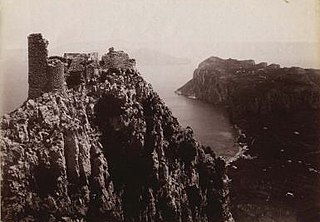
Castello Barbarossa is an archaeological ruin and ornithological station in Anacapri, on the island of Capri, Italy. It is named after the former corsair and Ottoman Kapudan Pasha (Admiral) Hayreddin Barbarossa, who stormed it in 1535 and destroyed it in 1544. The construction date is uncertain but it perhaps dates back to the late ninth century. From 1898, the structure, now in ruins, was owned by the Swedish psychiatrist Axel Munthe who donated it to his foundation. The surroundings, interesting for their botanical features, are home to the island's ornithological station.
The Grotta Bianca is a sea cave located on the island of Capri, Italy. It derives its name from white incrustations of calcareous matter upon its sides, and from clusters of white stalactites which hang from the roof and fringe the entrance. The cave faces east and is situated near the Punta della Chiavica. The entry, about 70–80 feet (21–24 m) high, leads into upper and lower caves, of which the former is not easily accessible. The lower cave can be entered by boat for a short distance. Unlike most other caves at the water-level, it is much broader at approximately 6 feet (1.8 m) above the water than actually at the surface. The total height is no more than 24 feet (7.3 m). The upper erosion line is clearly marked near the cave and within it. The upper cave seems to belong to an earlier period.

The Grotta Verde is a sea cave located on the island of Capri, southern Italy.

Santo Stefano is a Catholic church and former cathedral on the island of Capri, Italy. Dedicated to Saint Stephen, it is the principal house of worship in the town of Capri. The religious complex was built around the Piazza Umberto I square in the seventeenth century. The archbishop's palace is now used as the town hall ("Municipio"). Santo Stefano and Chiesa di San Costanzo are the island's two oldest churches.
Santa Maria del Soccorso is a church located within the archaeological site of Villa Jovis, on the island of Capri, Italy. It is situated on the summit of the Lo Capo hill at the eastern extremity of the island. The chapel-like church, was constructed ca. 1610. Its fittings include a bronze statue of the Madonna, a 1979 gift of the Caprese painter Guido Odierna (1913-1991). In the late 19th century, hermit lived at the church, keeping a visitor's book and selling wine.
References
- ↑ Giardino, Claudio (April 15–17, 2003). "The island of Capri in the Gulf of Naples between the 5th and the 2nd Millennium BC". Papers in Italian Archaeology VI. The Netherlands: Proceedings of the 6ú Conference of Italian Archaeology held at the University of Groningen, Groningen Institute of Archaeology. pp. 627, 628. Retrieved 6 July 2012.
40°32′56″N14°13′23″E / 40.5488°N 14.2231°E